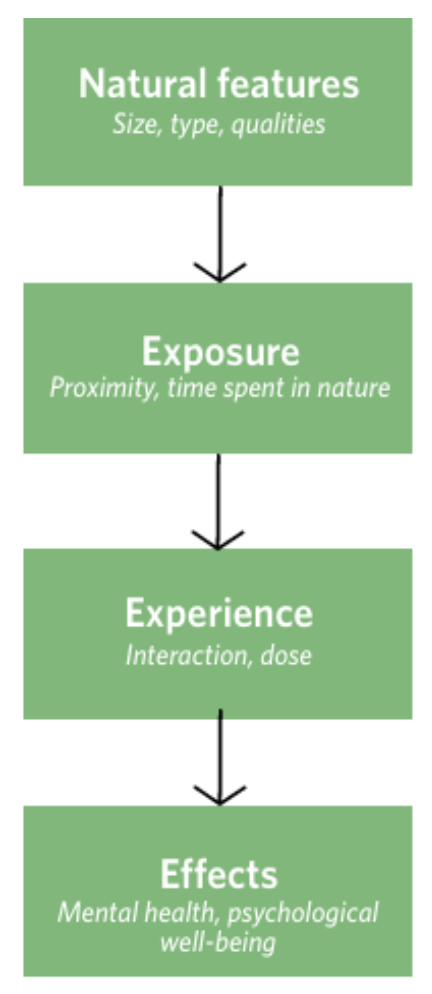Relationship Between Nature and Human Health
There is a growing interest in the connection between our natural environment and human health. An emerging body of evidence shows a positive association between green space contact and mental and physical health, which we describe below.
Physical Health
A study in 2019 by White et al. examined associations between the recreational contact with nature of 19,000+ English participants and their self-reported health and well-being in the week prior.45 Those who reported spending ≥ 120 minutes in nature in the last seven days reported significantly better health and well-being than those who reported no exposure. Interestingly, this relationship was also found for those with long-term illness or disability, purposing that the association did not simply imply that healthier people spend more time in nature.45 Based on these findings, the Park Prescription Program (PaRx) recommends two hours of nature time per week, for at least 20 minutes at a time.46
Further, a systematic review and meta-analysis of 103 observational studies and 40 intervention trials of populations of any age assessed the impacts of exposure to green space on various health outcomes.47 The meta-analysis demonstrated statistically significant reductions in heart rate, diastolic blood pressure, salivary cortisol, type 2 diabetes, and stroke incidence associated with increased green space exposure.47 It is worth noting that although this systematic review, published in 2018, did not implement date restrictions on its search strategy, 96% of studies meeting the inclusion criteria were from the previous ten years, revealing the expanding interest to understand the relationship between nature and human health.
Regarding child health outcomes, Wolch et al. recruited 3172 American children aged 9-12 years and longitudinally followed them for eight years to collect health data, including body mass index (BMI).48 The data were analyzed to evaluate the relationship between attained BMI growth by age 18 and environmental variables, such as park space and access to recreational programs. A significant inverse relationship was identified; a greater park acreage within a 500-meter radius of children’s homes was associated with a lower BMI at age 18. Additionally, a significant association was found between lower BMI at age 18 and an increased number of recreational programs within a 10 km radius of children’s homes.48
Mental Health

mental health as an ecosystem
service. Adapted from Science.org
A growing body of literature provides evidence of the benefits of nature on one’s mental health.49 Hunter et al. noted the benefits of spending time in nature for reducing stress. The authors measured stress biomarkers of 36 participants taken before and after a timed experience in nature.50 The authors found a stress reduction, with the greatest benefit of being in nature felt between the 20-to-30 minute mark.50 The Ontario Health Study highlighted the importance of green spaces in urbanized areas; people who lived in neighbourhoods with a higher density of trees on their streets reported significantly better mental health perceptions and significantly fewer cardio-metabolic conditions.51 They emphasized that an increased number of trees on a city block provided better perceptions of health comparable to an increase in income or a decrease in age.51
Nature and green spaces have always been important to humans’ psychological well-being, stemming from an evolutionary standpoint where humans have spent most of history interacting intimately with nature.49 There is a crucial and irreplaceable role for nature in brain development and cognition. For example, green spaces mitigate traffic-related air pollution and allow for increased outdoor physical activity, which has been found to improve mental wellbeing and have benefits for children. Regarded as an “ecosystem service,” which is the contribution of living nature in enhancing an individual’s quality of life, nature has also been identified as a determinant of mental health and illness.49 Its ability to improve sleep quality can protect against mental illnesses, such as depression.49 Nature has also been demonstrated to play a significant role in decreasing the incidence of other mental conditions such as anxiety disorders and attention deficit hyperactivity disorder (ADHD).52,53 Thus, the necessity of nature preservation and green spaces is evident and should be prioritized.
Mental Health Impacts of Climate Change
The relationship between mental health and the environment flows both ways. As the climate emergency worsens, scholars have noted the effects on our mental health at individual and societal levels.52,53 Four pathways have been identified in classifying the relationship between climate change and mental health; discrete events (e.g. natural disasters, extreme weather), direct effects from gradual changes (e.g. rising sea levels, increase in temperature), indirect effects associated with climate induced-changes to physical and social systems (e.g. political unrest), and perceptions of climate change (e.g. eco-anxiety).52
As climate change has led to increases in discrete events or extreme weather events, the literature has noted the consequences on mental health in the form of post-traumatic stress disorder (PTSD), depression, and anxiety disorders.52,54 These mental health impacts may persist long after the event has passed due to the potential of disruption to the physical and social environments. Furthermore, discrete events can have other long lasting impacts such as financial hardship, affecting mental health.52
While gradual changes are less visible immediately, they arguably affect more people in their severity and long-term consequences. Global warming, for example, has raised concern due to the causal relationship between warmer temperatures and aggression.55 Several studies have theorized the mechanisms driving the direct effects of temperature on aggression. Embodied cognition is a psychological concept that suggests our responses to environmental stimuli influence how we think. Heat-related aggression occurs as higher temperatures produce discomfort, which can precede increased irritability and hostile perceptions of others.55 Irritability can also result from the physiological effects of heat on emotional regulation. Simultaneously, the indirect effects of climate change on aggression include food insecurity and economic deprivation. Poor prenatal and postnatal nutrition can increase aggressive and anti-social behaviour.55,56

With the projected adverse effects of climate change on global food systems, reasonable evidence supports the hypothesis that climate change will increase violence. Furthermore, inequality and economic deprivation are predictors of violence. As climate change-related disasters affect the economy, employment, and living conditions, there is a trend of growing inequality and economic deprivation.55 Risk factors for aggression and violence may occur due to decreased life satisfaction and increased resentment.57
As first proposed by Glenn Albrecht, a Professor of Sustainability at Murdoch University, psychoterratic states represent an umbrella term for psychological and emotional responses to climate change.58 These conditions have been operationalized in the literature and are growing in notoriety:
- Solastalgia: Psychological distress produced by environmental change impacting people. At the same time, they are directly connected to their home environment, exacerbated by feelings of powerlessness.59
- Eco-anxiety: Anxiety related to the fear of the future of our environment.60
- Ecological grief: State of mourning caused by the loss of ecosystems, species, and landscapes.61
- Eco-paralysis: The inability to act on climate change due to feelings of distress and of hopelessness.62
These conditions are directly attributed to climate change and emphasize to an even greater extent how the destruction of our natural environment has negatively impacted not only our physical health but mental health at a societal level. Their classification is useful in understanding our response to stresses induced by environmental change and the resulting consequences to our infrastructure, systems, and populations.58
Dr. Stefan Grzybowski discusses how climate change could have negative impacts on our mental health but also how there is the opportunity for a lot of optimism about our own resilience (1:54)

